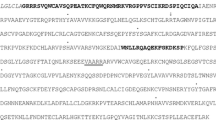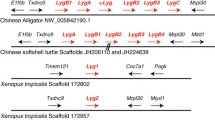Abstract
The trophoblast Kunitz domain proteins (TKDPs) are products of the outer cells (trophoblasts) of the placenta of cattle, sheep, and related species. Most are expressed abundantly for only a few days during the time at which the ruminant conceptus is first establishing intimate contacts with the uterine lining. The TKDPs are secretory proteins that possess a carboxyl-terminal peptidase inhibitory domain related to the Kunitz family of serine peptidase inhibitors. On the amino-terminal end are one or more highly unusual regions that are unique to the TKDP genes and have no apparent similarity to any other known sequences. The TKDPs are a rather divergent family that exhibits a good deal of variation among the members. To better understand the reason for such variation, the rates of synonymous (dS) and nonsynonymous (dN), as well as radical (p NR ) and conservative (p NC ), substitutions were assessed. Phylogenetic trees revealed that the Kunitz domains represented three related groups, whereas the amino-terminal domains formed four groupings. Pairwise comparisons between Kunitz and amino-terminal domain groups demonstrated that dN was consistently greater than dS. In addition, nonsynonymous substitutions in the Kunitz domains tended to be radical (changing charge or polarity), while those in the amino-terminal domains exhibited neither a preponderance of conservative nor radical substitution rates. In summary, the rapid evolution of the TKDPs, coupled with their restricted temporal expression during development, likely reflects the establishment of protein-protein interactions that have evolved to serve the unusual synepitheliochorial placenta of ruminant ungulates.




Similar content being viewed by others
References
Arnoux B, Merigeau K, Saludjian P, Norris F, Norris K, Bjorn S, Olsen O, Petersen L, Ducruix A (1995) The 1.6 A structure of Kunitz-type domain from the alpha 3 chain of human type VI collagen. J Mol Biol 246:609–617
Civetta A (2003) Positive selection within sperm-egg adhesion domains of fertilin: an ADAM gene with a potential role in fertilization. Mol Biol Evol 20:21–29
Clark AG, Glanowski S, Nielsen R (2003) Inferring nonneutral evolution from human-chimp-mouse orthologous gene trios. Science 302:1960–1963
Creighton TE, Charles IG (1987) Biosynthesis, processing and evolution of bovine pancreatic trypsin inhibitor. Cold Spring Harbor Symp Quant Biol 52:511–519
Cross JC, Werb Z, Fisher SJ (1994) Implantation and the placenta: key pieces of the development puzzle. Science 266:1508–1518
Elder JGJ, Turner BJ (1995) Concerted evolution of repetitive DNA sequences in eukaryotes. Q Rev Biol 70:297–320
Green J, Xie S, Roberts R (1998) Pepsin-related molecules secreted by trophoblast. Rev Reprod 3:62–69
Hill RE, Hastie ND (1987) Accelerated evolution in the reactive centre regions of serine protease inhibitors. Nature 326:96–99
Hughes AL (1994) The evolution of functionally novel proteins after gene duplication. Proc R Soc Lond B Biol Sci 256:119–124
Hughes AL (1995) The evolution of the type I interferon gene family in mammals. J Mol Evol 41:539–548
Hughes AL (1999a) Adaptive evolution of genes & genomes. Oxford University Press, New York
Hughes AL (1999b) Evolutionary diversification of the mammalian defensins. Cell Mol Life Sci 56:94–103
Hughes AL, Roberts RM (2000) Independent origin of alpha and beta interferon in birds and mammals. J Interferon Cytokine Res 20:737–739
Hughes AL, Ota T, Nei M (1990) Positive Darwinian selection promotes charge profile diversity in the antigen-binding cleft of class I major-histocompatibility-complex molecules. Mol Biol Evol 7:515–524
Hughes AL, Green JA, Garbayo JM, Roberts RM (2000) Adaptive diversification within a large family of recently duplicated, placentally-expressed genes. Proc Natl Acad Sci USA 97:3319–3323
Hughes AL, Green JA, Piontkivska H, Roberts RM (2003) Aspartic proteinase phylogeny and the origin of pregnancy-associated glycoproteins. Mol Biol Evol 20:1940–1945
Hynes T, Randal RM, Kennedy LA, Eigenbrot CA, Kossiakoff A (1990) X-ray crystal structure of the protease inhibitor domain of Alzheimer’s amyloid beta-protein precursor. Biochemistry 29:10018–10022
King GJ, Atkinson BA, Robertson HA (1982) Implantation and early placentation in domestic ungulates. J Reprod Fertil Suppl 31:17–30
Kumar S, Tamura K, Jakobsen IB, Nei M (2001) MEGA2: Molecular Evolutionary Genetics Analysis software. Bioinformatics 17:1244–1245
Laskowski M, Kato I (1980) Protein inhibitors of proteinases. Annu Rev Biochem 49:593–626
Leaman DW, Cross JC, Roberts RM (1992) Genes for the trophoblast interferons and their distribution among mammals. Reprod Fertil Dev 4:349–353
Leiser R, Kaufmann P (1994) Placental structure: in a comparative aspect. Exp Clin Endocrinol 102:122–134
Lynch M, Conery JS (2000) The evolutionary fate and consequences of duplicate genes. Science 290:1151–1155
Lynch M, Force A (2000) The probability of duplicate gene preservation by subfunctionalization. Genetics 154:459–473
Lynch M, O’Hely M, Walsh B, Force A (2001) The probability of preservation of a newly arisen gene duplicate. Genetics 159:1789–1804
MacLean II JA, Chakrabarty A, Xie S, Bixby JA, Roberts RM, Green JA (2003) Family of Kunitz proteins from trophoblast: expression of the trophoblast Kunitz domain proteins (TKDP) in cattle and sheep. Mol Reprod Devel 65:30–40
MacLean II JA, Roberts RM, Green JA (2004) Atypical Kunitz-type Serine proteinase inhibitors produced by the ruminant placenta. Biol Reprod 71:455–463
MacLean II JA, Chen MA, Wayne CM, Bruce SR, Rao M, Meistrich ML, Macleod C, Wilkinson MF (2005) Rhox: a new homeobox gene cluster. Cell 120:369–382
McAllister BF, Werren JH (1999) Evolution of tandemly repeated sequences: What happens at the end of an array? J Mol Evol 48:469–481
Nei M, Gojobori T (1986) Simple methods for estimating the numbers of synonymous and nonsynonymous nucleotide substitutions. Mol Biol Evol 3:418–426
Nei M, Jin L (1989) Variances and average numbers of nucleotide substitutions within and between populations. Mol Biol Evol 6:290–300
Ngai J, Dowling MM, Buck L, Axel R, Chess A (1993) The family of genes encoding odorant receptors in the channel catfish. Cell 72:657–666
Ohno S (1973) Ancient linkage groups and frozen accidents. Nature 244:259–262
Paulding C, Ruvolo AM, Haber DA (2003) The Tre2 (USP6) oncogene is a hominoid-specific gene. Proc Natl Acad Sci USA 100:2507–2511
Perry JS (1981) The mammalian fetal membranes. J Reprod Fertil 62:321–335
Pritchard L, Dufton MJ (1999) Evolutionary trace analysis of the Kunitz/BPTI family of proteins: functional divergence may have been based on conformational adjustment. J Mol Biol 285:1589–1607
Qin L, Denda K, Shimomura T, Kawaguchi T, Kitamura N (1998) Functional characterization of Kunitz domains in hepatocyte growth factor activator inhibitor type 2. FEBS Lett 436:111–114
Roberts RM, Mathialagan N, Duffy JY, Smith GW (1995) Regulation and regulatory role of proteinase inhibitors. Crit Rev Eukaryotic Gene Express 5:385–436
Roberts RM, Liu L, Alexenko A (1997) New and atypical families of type I interferons in mammals: comparative functions, structures and evolutionary relationships. Prog Nucleic Acid Res Mol Biol 56:287–325
Roberts RM, Ealy AD, Alexenko AP, Han CS, Ezashi T (1999) Trophoblast interferons. Placenta 20:259–264
Saitou N, Nei M (1987) The neighbor-joining method: a new method for reconstructing phylogenetic trees. Mol Biol Evol 4:406–425
Soares MJ (2004) The prolactin and growth hormone families: pregnancy-specific hormones/cytokines at the maternal-fetal interface. Reprod Biol Endocrinol 2:10.1186/1477-7827-2-51
Sol-Church K, Picerno GN, Stabley DL, Frenck J, Xing S, Bertenshaw GP, Mason RW (2002) Evolution of placentally expressed cathepsins. Biochem Biophys Res Commun 293:23–29
Swanson WJ, Vacquier VD (1998) Concerted evolution in an egg receptor for a rapidly evolving abalone sperm protein. Science 281:710–712
Swanson JW, Vacquier VD (2002) The rapid evolution of reproductive proteins. Nature Rev (Genet) 3:137–144
Torgerson DG, Kulathinal RJ, Singh RS (2002) Mammalian sperm proteins are rapidly evolving: evidence of positive selection in functionally diverse genes. Mol Biol Evol 19:1973–1980
Vogel T, Evans D, Urvater J, O’Connor D, Hughes A, Watkins D (1999) Major histocompatability complex class I genes in primates: co-evolution with pathogens. Immunol Rev 167:327–337
Waterston RH, Lindblad-Toh K, Birney E, Rogers J, Abril JFea (2002) Initial sequencing and comparative analysis of the mouse genome-mouse genome sequencing consortium. Nature 420:520–562
Wiemers DO, Shao LJ, Ain R, Dai G, Soares MJ (2003) The mouse prolactin gene family locus. Endocrinology 144:313–325
Wooding FB (1992) Current topic: the synepitheliochorial placenta of ruminants: binucleate cell fusions and hormone production. Placenta 13:101–113
Zhang J, Rosenberg HF, Nei M (1998) Positive Darwinian selection after gene duplication in primate ribonuclease genes. Proc Natl Acad Sci USA 95:3708–3713
Acknowledgments
This work was supported by the Animal Reproductive Biology Group of the University of Missouri—Columbia, Food for the Twenty-first Century Program, and NIH Grant HD21896.
Author information
Authors and Affiliations
Corresponding author
Additional information
[Reviewing Editor: Dr. Martin Kreitman]
Rights and permissions
About this article
Cite this article
Chakrabarty, A., MacLean, J.A., Hughes, A.L. et al. Rapid Evolution of the Trophoblast Kunitz Domain Proteins (TKDPs)—A Multigene Family in Ruminant Ungulates. J Mol Evol 63, 274–282 (2006). https://doi.org/10.1007/s00239-005-0264-3
Received:
Accepted:
Published:
Issue Date:
DOI: https://doi.org/10.1007/s00239-005-0264-3




